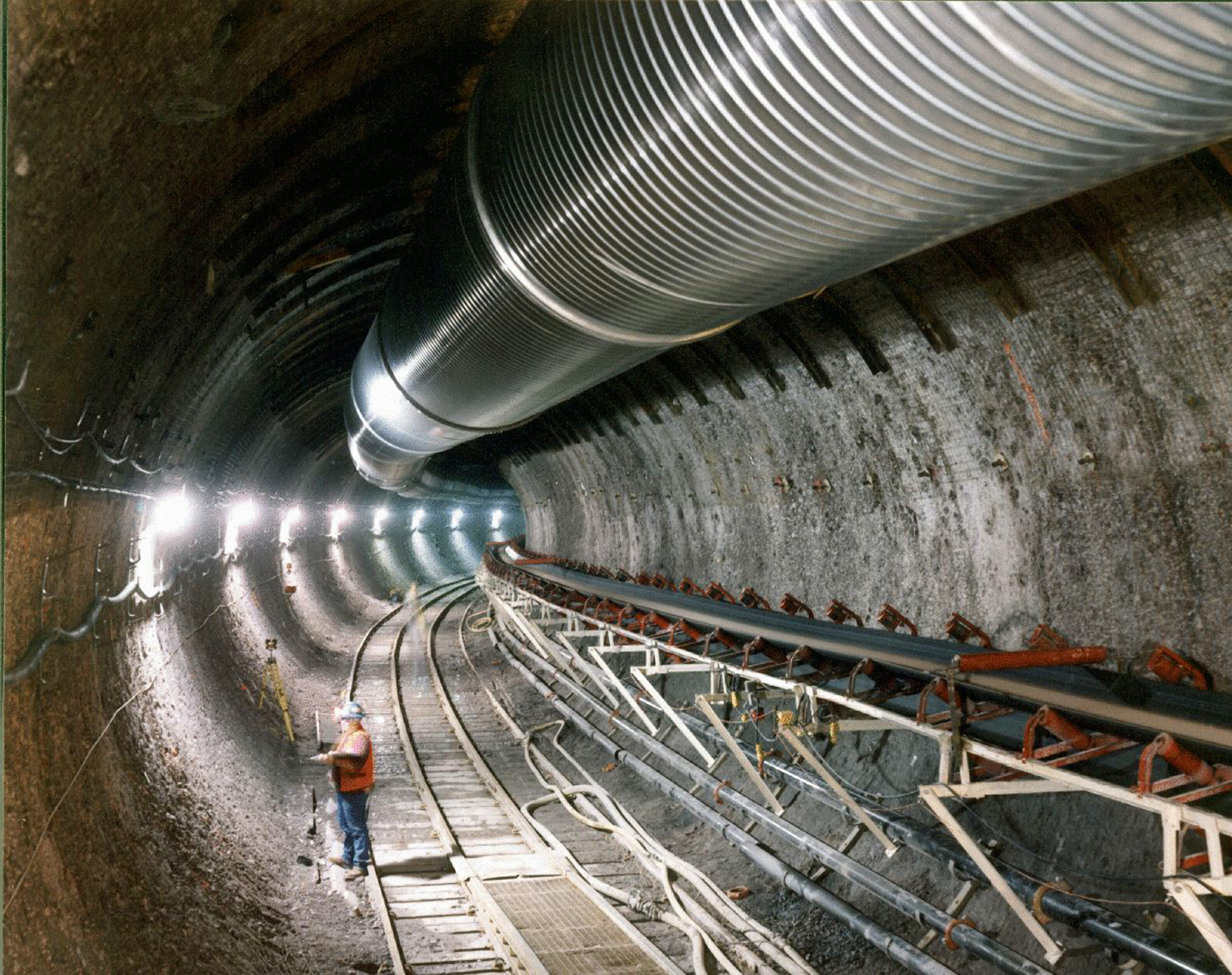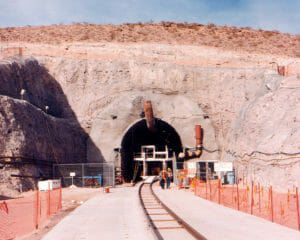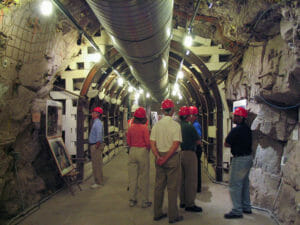Indy Explains: The fight over Yucca Mountain

If you live in Nevada, chances are you’ve heard about Yucca Mountain — and probably more than once.
The name surfaces every election season as politicians vow to protect the Silver State from a controversial nuclear waste dump. The political hot potato goes back decades, so if you’re fuzzy on where the project stands, don’t fret. You’re likely not alone.
But brace yourselves for more discussion in the weeks and months to come, given its inclusion in the White House’s 2018 budget plan, which calls for $120 million to restart licensing activities for Yucca Mountain.
Here’s everything you need to know about Yucca Mountain, including its location, history and status:
What is Yucca Mountain, and where is it?

Yucca Mountain has become synonymous with the fight over where to store the country’s nuclear waste. It lies about 100 miles northwest of Las Vegas in Nye County, sitting on federal land near the edge of the Nevada Test Site.
Proponents describe it as a desert mountain in the middle of nowhere and contend it’s safer to bury waste 1,000 feet below ground than to have it sitting at 76 different sites across the country. If that isn’t safe, what is? they ask.
But opponents says the site is geologically and hydrologically complex — unworkable for a sensitive repository that must keep its radiation levels in check for a million years. They say it has corrosive conditions underground, is prone to earthquakes and is even subject to volcanic activity. Groundwater moves quickly from the repository’s proposed boundaries to the aquifer below and could bring waste with it, they argue.
Over the years, the Department of Energy has proposed man-made workarounds to compensate for the challenging environmental conditions, such as better waste containers and titanium "drip shields" to keep out water. Opponents think the government could dispose of waste cheaper and more safely if they found a better natural environment, such as salt mines.
Right now, all that’s at the site is a 5-mile-long, horseshoe-shaped tunnel that allows researchers to study the environmental conditions underground. A functional repository would require constructing at least 42 more miles of tunnels to deposit 70,000 metric tons of waste, and an additional 45 miles of tunnels if the capacity rose to 150,000 metric tons of the heavy metal.
It would also require surface facilities to receive and handle the waste, and more than 300 miles of new railroad, which would constitute the longest new rail construction project in a century and cost at least $2.7 billion, according to the state.
Beyond the lack of waste disposal infrastructure, the proposed design of a nuclear waste disposal canister is now obsolete, and there’s no existing railroad to the site. That’s become even more difficult after President Barack Obama designated 704,000 acres of public land in the middle of Nevada as the Basin and Range National Monument, expanding protections for the wilderness and foiling plans to put a railroad through it.
Opponents in Nevada are not convinced beyond a shadow of a doubt that the proposed Yucca dump can isolate radioactive waste for at least 10,000 years, and that it won’t harm Nevada’s residents, ecosystem or economy.
How did it come about?
The Department of Energy first started studying Yucca Mountain as a repository for long-term storage of spent nuclear fuel and high-level radioactive waste in 1978. But it wasn’t until four years later, with the Nuclear Waste Policy Act (NWPA) of 1982, that Congress established a repository site screening process.
Proponents have argued that the U.S. needs a place to dispose of spent nuclear fuel to consolidate waste that’s stored throughout the country — including close to heavily populated areas — that could contribute to a Fukushima-like disaster and poison or kill people.
Yucca was identified as one of several potential repository sites through that screening process, but in 1987, Congress amended the NWPA to designate Yucca was the sole repository site (known as the “Screw Nevada Bill”). Opponents say that since then, the Department of Energy has tried to do whatever it took to ensure Yucca Mountain appeared to be a viable site, in spite of logistical concerns.
Surface studies began at Yucca Mountain in 1991, with grading work at the site beginning two years later.
In 1994, a portal entrance to the Exploratory Studies Facility was constructed, which critics of the project said was unnecessary for a study area but would be necessary for a repository site. Thermal testing at the site began in 1997.
Work continued on the site over the next several years while the state of Nevada sued the EPA over proposed radiation standards for Yucca Mountain and the Department of Energy continued its work on its license application to the Nuclear Regulatory Commission, which was submitted in 2008. The following year, Energy Secretary Steven Chu, under President Barack Obama’s administration, said that a repository at Yucca Mountain is “off the table.”
While pressure is still on to find a storage site, Nevada officials were heartened when the NRC determined in 2014 that spent nuclear fuel can be safely kept at the production site in dry casks for up to 160 years. Opponents of the site say that reduces the urgency for a place like Yucca.
What have politicians done about it?
Powerful Democratic Sen. Harry Reid, who retired this year, vigorously fought the project and repeatedly contended that it was dead. State officials are concerned that the loss of such a senior member of Congress, and the dramatic ideological shift from the anti-Yucca Obama Administration to the Trump Administration, will embolden those seeking to revive the project.
Nevada’s congressional delegation has been mostly united in its opposition, and members are pushing legislation for a “consent-based process” that would allow spending on a waste repository only if the host state, tribes and affected counties give written permission to the Secretary of Energy. Five of the state’s six-member congressional delegation issued statements decrying the budget allocation less than 24 hours after the Trump Administration’s Wednesday announcement.
“If Yucca Mountain has taught us anything, it is that trying to force a repository on an unwilling state only gets the nation further away from a workable and safe solution to nuclear waste disposal,” the Agency for Nuclear Projects within the governor’s office said in a report released earlier this year.
Some lawmakers have broken with the delegation, saying that they don’t think that Yucca Mountain should be off the table. They include former Republican Rep. Cresent Hardy and Republican Rep. Mark Amodei. While Amodei does not believe Yucca should become a “simple dumping site” for U.S. nuclear waste, he has said that “Nevadans cannot simply ignore Yucca Mountain and think it is off the table,” urging Nevadans to “work to dictate the terms of the repository under the best conditions for our state.”
“This facility has the potential to not only be a job creator in Nye County, but also throughout the state if done properly,” Amodei said.
How is the state fighting?
The state has its own Agency for Nuclear Projects that works against the proposal alongside the Nevada attorney general’s office. It’s been preparing legal documents and collecting scientific data in the past 3 1/2 years in anticipation that the project would rev up again, and is requesting a combined total of $3.6 million in each of the next two years to defend the state against the development.
“We didn’t de-mobilize when the program seemed to be going away,” Robert Halstead, executive director of the agency, told lawmakers this week.
Nevada has fought the proposal, raising 218 “contentions” against the idea that have been accepted by NRC licensing boards. Their concerns range from geological obstacles to potential deterioration of waste disposal containers to the practicality of barriers that would keep water out of the waste disposal tunnels.
State officials recommend that if the project gets going again, they need to launch a public information campaign to rally opposition against Yucca in Nevada and beyond.
One of their key arguments is that a repository would attract a loaded cask of nuclear waste approximately every day for 50 years or more, from 76 sites around the country. That means the hazardous material would traverse 44 states and the lands of 30 tribes, through 22,000 miles of railways and 7,000 miles of highway. Between 10 and 12 million people live within a half mile of those roads and railways.
Tourism could also take a hit. Part of the Las Vegas Strip, and about 50,000 hotel rooms, are within a half mile of the rail route that would ship the radioactive material.
Transporting nuclear waste could be dangerous to the health of the workers who do it, raising the risk of cancer, but Halstead’s biggest concern is the catastrophe that could ensue if terrorists attacked a train or truck, releasing its deadly contents and incurring hundreds of millions of dollars in cleanup costs.
What is licensing?

To start constructing and operating the repository, the U.S. Department of Energy must obtain a license from the U.S. Nuclear Regulatory Commission. That involves both a technical review by NRC staff and a lengthy, trial-style "adjudicatory" process that would include cross examination of expert witnesses and an estimated 400 days of hearings.
The Energy Department submitted a license application that was thousands of pages long in 2008, but the adjudicatory process has been suspended and Congress, under Reid’s leadership, hasn’t provided the funding needed to pay for those proceedings. If the process restarts, Nevada would then be on the hook to meet short deadlines and quickly respond to filings.
After the lengthy proceeding, a licensing board and then the commission itself would issue a verdict on whether the development should go forward. Parties could appeal the outcome in court; the whole process is expected to take years.
Halstead is bullish about Nevada’s chances against the federal government, which he says is using bad science to argue for Yucca.
"Everything that the Department of Energy has done since 1987 is to put political science ahead of earth science," he said.
His legal team has been building its case full-time for several years with backing from a supportive Legislature.
"I think they’re going to be surprised at what they’ve gotten themselves into," he said of the federal government. "I think they’ll wish it was a fight they hadn’t picked."
How much will it cost?
Department of Energy officials estimate that a Yucca Mountain repository could cost a total of $97 billion including construction, operation for 100 years and closure. That includes the estimated $14.5 billion the government has already spent on it.
The licensing process itself could cost $1.66 billion over 10 years, according to Energy Department estimates from 2008. The NRC estimates it needs $330 million to go through with licensing.
Money to pursue the project came from a charge on nuclear electricity customer bills of one-tenth of one cent per kilowatt hour.
Nevada expects it can fight the development with a budget of $8 million to $10 million each year of the licensing proceeding.
Who wants it?
While top-ranking Nevada officials oppose the project, Nye County — where Yucca Mountain would be located — is in favor, saying it would boost the economy of a county with one of the highest unemployment rates in the state.
“It is Nye County’s contention this funding will do just the opposite: re-establish well-paying jobs that were lost, create new high-tech and construction jobs and strengthen Nevada’s infrastructure,” Nye County Commission Chair Dan Schinhofen said in a statement.
Nye County also earns Payments Equal to Taxes -- money that the federal government gives to counties with federal property in their boundaries that they can’t tax. At its peak in 2007, the 42,000-resident county brought in $11.25 million for hosting Yucca.
Illinois Republican Rep. John Shimkus is one of the most vocal congressional proponents of reviving the project, calling it the “fastest, best and most viable solution” to long-term storage of nuclear waste. Shimkus, the chairman of the House Energy and Commerce Subcommittee for the Environment, has held congressional hearings, toured the site itself and is preparing legislation dealing with some of the complex land and water use issues that need to be solved if the facility is to be reopened.
Other entities sued in 2011 to restart Yucca’s stalled licensing process. They included the states of South Carolina and Washington, Aiken County in South Carolina, the National Association of Regulatory Utility Commissioners, several individuals from Washington State, and eventually Nye County.
In a split decision in 2013, a three-judge panel of the U.S. Court of Appeals for the District of Columbia ordered the Nuclear Regulatory Commission to proceed with the licensing process, even though the NRC only had about $13 million to work with and would need far more than that. Chief Judge Merrick Garland, who Obama later nominated for the Supreme Court, was strongly opposed, saying he was being asked to do a “useless thing.”
Other counties have expressed interest in being interim storage facilities. They included Andrews County, Texas, and Eddy and Lea Counties in New Mexico. Those temporary facilities could hold waste for 40 years or more in dry storage systems.
Nevada officials who disagree with Nye County’s support of the project say they want to make it abundantly clear to national policymakers that the state overall is firmly against Yucca.
“My problem with Nye County is they want to sell out for a bowl of oatmeal,” Halstead said.
What’s the status of the project?
The Trump Administration’s proposal to add $120 million breathes new life into the project, which had been starved of the money to continue the licensing process. But the allocation would be a fraction of the money needed to pursue the fight against Nevada and is more of a symbolic move, according to Halstead.
Trump’s $1.1 trillion “skinny budget” released this week is just the first step in a longer process that will lead to a more comprehensive spending plan from the administration this spring. That document will inform Congress as they create their own budget.
It’s possible that Congress won’t come to an agreement on a budget for the spending category that includes Yucca, or that the expenditure isn’t a hill to die for for the Trump Administration and gets exchanged for other concessions.
Halstead estimates that with all the layers of approval and expenses, nuclear waste wouldn't be going into the ground in Nevada for another 20 years even if licensing moves forward and the Department of Energy succeeds.
One thing is clear though: Nevada’s most powerful political leaders plan to put up a fight.
“This project was ill-conceived from the beginning and has already flushed billions of taxpayer dollars down the drain,” Republican Sen. Dean Heller said in a joint statement with his counterpart, Democratic Sen. Catherine Cortez Masto. “Washington needs to understand what Nevada has been saying for years: we will not be the nation’s nuclear waste dump.”



